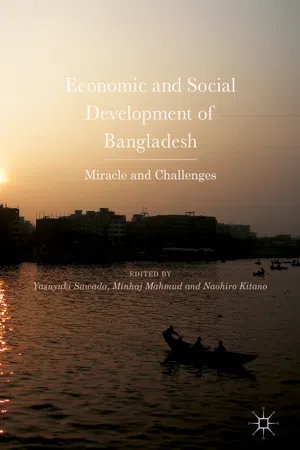Introduction
Bangladesh began its journey as an independent country in December 1971. At the time, its long-term economic prospects were questioned by development pundits, who deemed it to be a test case for development (Faaland and Parkinson 1976). Such negative perceptions of Bangladesh’s development prospects were fostered by weak initial conditions within the country: problems such as high population density, the dominance of stagnant and unproductive agriculture, the prevalence of malnutrition, a limited natural resource base, under-developed infrastructure, and exposure to frequent natural disasters (Hossain et al. 2012). In the 1970s, Bangladesh was ranked near the bottom of all the economic and social indices that looked at factors such as income, poverty, child mortality, and school enrollment rates. However, over subsequent decades, the country gradually improved the lives of its people and the social status of women through achieving a steady growth in per capita income. Accordingly, the initial negative perception of the Bangladeshi economy has been gradually replaced with cautious optimism in global development circles. For the last decade, Bangladesh has achieved sustained economic growth of more than 5% per annum. In terms of poverty reduction, human development, and social indicators, the growth in its economy has enabled substantial progress toward the achievement of the millennium development goals. According to the latest World Bank report, over 15 million Bangladeshis have moved out of poverty since 1992 (World Bank 2016). Accelerated growth in the last decade has paved the way for the country to achieve (lower) middle income status.
The key to Bangladesh’s success lies in the reallocation of relatively low-skilled laborers from the agricultural to the non-agricultural sector, and from rural to urban areas; this is representative of the inter-sectoral transformation common to other Asian countries (Hossain et al. 2012; Otsuka 2007). The “green revolution,” that is, the adoption of irrigation and high-yielding rice seeds together with the introduction of chemical fertilizers, played a central role in breaking the vicious cycle of poverty, provided alternatives to farming as a major occupation, and curbed the tendency to sacrifice children’s schooling in favor of work in the fields. Agriculture provided the dominant source of income and funds for physical and human capital investment. Moreover, the growing farm–non-farm linkages created pro-poor job opportunities particularly in the non-farm sectors. In this context, Bangladesh’s experience was similar to other Asian countries (Otsuka et al. 2008; Sawada and Lokshin 2009). The government’s role in providing physical and institutional infrastructure also facilitated the process of structural transformation from farm-based to non-farm-based economies.
The achievement of Bangladesh’s development transformation in such an accelerated manner was fueled by three rather country-specific mechanisms. First, the penetration of MFIs into rural communities relaxed credit constraints on rural poor households, thereby facilitating development transformation. Second, export-led manufacturing growth led by the RMG sector as well as the rapid expansion of international migration accelerated structural transformation. Finally, unlike many of the countries in Asia and Africa, Bangladesh is among the world’s most populated countries; this indicates a possibility for high-returns to investment in infrastructure, which tends to be ...
